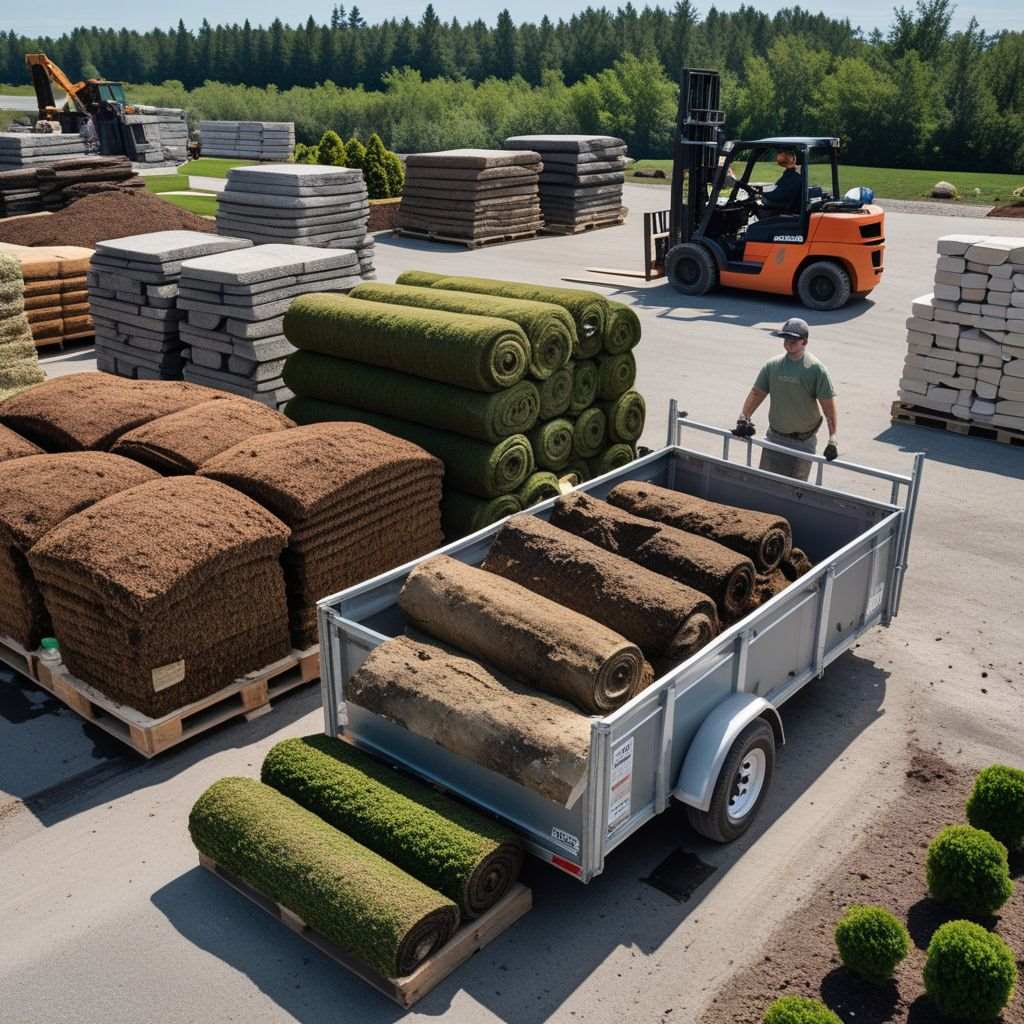Turn Dirt into Dollars: Proven Steps to Start Your Own Landscaping Business Today

The allure of transforming outdoor spaces and cultivating natural beauty is a powerful motivator for many aspiring entrepreneurs. In Canada, the landscaping industry presents a robust and evergreen opportunity for those looking to build a thriving business. Far from being a seasonal endeavor, landscaping services are in consistent demand across residential, commercial, and municipal sectors, offering a pathway to significant financial success and personal fulfillment.
This comprehensive guide will walk you through the essential steps to establish and grow your own landscaping business in Canada, from initial market research to securing the necessary permits and cultivating a strong brand presence. We’ll delve into the unique aspects of the Canadian market, providing insights that will help you navigate the regulatory landscape, understand regional nuances, and capitalize on emerging trends to turn your passion for green spaces into a profitable venture.
1. Know Your Niche: How to Analyze the Canadian Landscaping Scene
Before digging into the operational aspects of your landscaping business, a thorough understanding of the Canadian market is paramount. This isn’t just about identifying potential clients; it’s about understanding the unique demands, climate considerations, and competitive landscape that define the Canadian context. The Canadian landscaping services market generated approximately USD 13.62 billion in 2022 and is projected to reach USD 21.75 billion by 2030, indicating a healthy and growing sector [1].
Localized Demand and Climate Considerations
Canada’s vast and diverse geography means that landscaping needs can vary significantly from one region to another. For instance, businesses in British Columbia might focus on drought-tolerant landscaping due to drier summers, while those in the Prairies may specialize in hardy plants that can withstand harsh winters.
In urban centers like Toronto, Montreal, or Vancouver, demand for compact garden designs, vertical gardens, and balcony landscaping might be higher due to limited space. Conversely, rural areas could present opportunities for larger-scale property maintenance, agricultural landscaping, or even snow removal services, which can provide a crucial revenue stream during the colder months.

Your market study should involve:
- Demographic Analysis: Who are your potential clients? Are they homeowners, businesses, or public institutions? Understanding their income levels, property sizes, and aesthetic preferences will help you tailor your services.
- Geographic Focus: Define your service area. Consider the travel time between jobs, the density of potential clients, and local bylaws related to noise, water usage, and waste disposal.
- Seasonal Variations: Plan for the distinct Canadian seasons. While spring and summer are peak times for planting, mowing, and garden design, autumn brings leaf removal and winter opens doors for snow and ice management. Diversifying your services to include year-round offerings can significantly stabilize your income.
Competitive Landscape and Pricing Strategies
Analyze existing landscaping businesses in your chosen area. What services do they offer? How do they price their services? What are their strengths and weaknesses? This research will help you identify gaps in the market or areas where you can differentiate your business. Consider:
- Niche Specialization: Instead of offering every service, consider specializing in areas like sustainable landscaping, xeriscaping, hardscaping (patios, walkways), irrigation systems, or even specific plant care. Specialization can help you stand out and attract a dedicated client base.
- Pricing Models: Research average rates for various landscaping services in your region. Factors influencing pricing include the complexity of the job, the materials required, labor costs, and your desired profit margin. Offering tiered pricing or package deals can appeal to a wider range of clients.
By meticulously studying your market, you’ll lay a solid foundation for a business that is not only viable but also strategically positioned for success within the Canadian landscaping industry.
References
[1] Grand View Research. (n.d.) Outlook and Market Growth Forecast for Canada’s Landscaping Sector (2030). Retrieved from Grand View Research – Landscaping Services Market (Canada)
2. Build a Blueprint: Crafting a Canadian Landscaping Business Plan
Once you have a clear understanding of your target market and the services you intend to offer, the next crucial step is to develop a comprehensive business plan. This document serves as your roadmap, outlining your business goals, strategies, and financial projections. For Canadian entrepreneurs, a well-structured business plan is not only essential for internal guidance but also a critical requirement when seeking financing from banks or government programs.
Key Components of a Canadian Landscaping Business Plan
Your business plan should be a dynamic document, evolving as your business grows. It typically includes the following sections:
- Executive Summary: A concise overview of your entire business plan, highlighting your mission, vision, and key objectives. Although it appears at the beginning of your plan, it’s typically written after completing the other sections.
- Company Description: Detail your business structure (sole proprietorship, partnership, corporation), your legal name, and your business goals. Explain what makes your landscaping business unique in the Canadian market.
- Market Analysis: Expand on your initial market study, providing in-depth research on your target market, industry trends, and competitive analysis. Discuss how you plan to address the specific needs of Canadian clients.
- Services Offered: Clearly define the landscaping services you will provide. Consider how these services align with Canadian climate, local flora, and common property types. For example, will you offer winter services like snow removal or holiday lighting installation?
- Marketing and Sales Strategy: Outline how you will attract and retain customers in Canada. This could include digital marketing (local SEO, social media), traditional advertising (local flyers, community newspapers), and networking within Canadian communities. Emphasize how you will build a strong local reputation.
- Team Overview: Highlight the professional background and strengths of your team. If operating solo, focus on your own skills and any mentors or advisors contributing to the business.
- Operational Plan: Describe how your business will function day to day, including how you’ll manage your team, oversee projects, and coordinate logistics. Outline your equipment needs—especially considering Canadian weather—and explain how you plan to handle sourcing, storage, and delivery. Highlight strategies for maintaining client relationships and ensuring project timelines are met.
- Financial Projections: This is a critical section for any business, especially when seeking funding. Include:
- Startup Costs: Itemize all initial expenses, such as equipment purchases, vehicle acquisition, insurance, permits, and initial marketing efforts. Be realistic about the costs of operating in Canada, which can vary by province.
Also Read: Wealthsimple’s 2025 Cash Bonus Mastercard Could Help New Entrepreneurs
- Revenue Forecasts: Project your sales for the first three to five years, based on your pricing strategy and market demand. Consider seasonal fluctuations inherent in the Canadian landscaping industry.
- Operating Expenses: Detail your ongoing costs, including labor, fuel, maintenance, marketing, and administrative expenses.
- Cash Flow Statement: Project your cash inflows and outflows to ensure you have sufficient liquidity to cover expenses.
- Profit and Loss Statement: Forecast your profitability over time.
- Break-Even Analysis: Determine the point at which your revenue covers your costs.

Canadian Funding Opportunities
For Canadian entrepreneurs, several resources can assist with business planning and funding:
- Business Development Bank of Canada (BDC): Offers financing, advisory services, and resources specifically for Canadian small and medium-sized businesses.
- Futurpreneur Canada: Provides financing, mentoring, and support to young entrepreneurs (18-39 years old) across Canada.
- Provincial and Territorial Programs: Each province and territory may have specific grants, loans, or support programs for new businesses. Research programs in your specific region (e.g., Ontario’s Small Business Enterprise Centres, British Columbia’s Small Business BC).
- Local Credit Unions and Banks: Traditional financial institutions are often a source of small business loans.
A well-researched and thoughtfully constructed business plan will not only guide your decisions but also instill confidence in potential investors and partners, setting your Canadian landscaping business on a path to sustained growth.
3. Brand Like a Pro: Creating a Landscaping Identity Clients Remember
In the competitive Canadian landscaping market, establishing a distinct and memorable brand is crucial for attracting and retaining clients. Your brand is more than just a logo; it’s the sum of your business’s values, personality, and the promise you make to your customers. A strong brand identity helps you stand out from the competition and builds trust and recognition within your community.
Naming Your Canadian Landscaping Business
Choosing a name is often the first step in brand creation. Consider names that are:
- Memorable and Easy to Pronounce: Avoid overly complex or difficult-to-spell names.
- Relevant to Landscaping: The name should ideally convey what your business does.
- Reflective of Your Niche (if any): If you specialize in certain services (e.g., ‘Eco-Scape Designs’ for sustainable landscaping), incorporate that into your name.
- Available: Crucially, check for availability of the business name with your provincial or territorial corporate registry, and ensure the corresponding domain name and social media handles are also available.
Many Canadian landscaping businesses incorporate local elements into their names, such as regional flora, geographical features, or even Indigenous languages (with proper respect and consultation). This can resonate well with local clients and foster a sense of community connection.
Developing Your Visual Identity
Your visual identity includes your logo, color palette, typography, and overall aesthetic. These elements should be consistent across all your marketing materials, from your website and social media profiles to your uniforms and vehicle wraps.
- Logo Design: Invest in a professional logo that is scalable, versatile, and visually appealing. Consider hiring a local Canadian graphic designer who understands the regional aesthetic.
- Color Palette: Choose colors that evoke nature, freshness, and professionalism. Green, brown, blue, and earthy tones are popular choices in the landscaping industry.
- Typography: Select fonts that are legible and align with your brand’s personality ‒ whether modern, traditional, or rustic.
Crafting Your Brand Message and Values
Beyond the visual, your brand encompasses your message and the values you uphold. What do you want your customers to feel when they interact with your business? Are you focused on sustainability, precision, creativity, or customer service excellence?
- Mission Statement: A concise statement outlining your business’s purpose and what it aims to achieve.
- Vision Statement: Describes what your business aspires to become in the future.
- Core Values: The guiding principles that dictate your business’s behavior and decisions. For example, many Canadian landscaping companies emphasize environmental stewardship, using native plants, and sustainable practices.

Online Presence and Branding
In today’s digital age, a strong online presence is non-negotiable. Your website and social media channels are extensions of your brand.
- Professional Website: Your website should showcase your portfolio, list your services, provide contact information, and ideally include testimonials from satisfied Canadian clients. Ensure it’s mobile-friendly and easy to navigate.
- Social Media: Platforms like Instagram, Facebook, and Pinterest are excellent for showcasing your work visually. Share before-and-after photos, seasonal tips relevant to Canadian gardening, and engage with your local community. Consider using local hashtags to reach your target audience.
- Google My Business: Optimize your Google My Business profile to ensure your business appears in local search results, a critical tool for Canadian customers searching for local services.
By thoughtfully developing each aspect of your brand, you’ll create a cohesive and compelling identity that resonates with the Canadian market and sets the stage for long- term success.
4. Set Your Pricing: Building a Transparent and Profitable Rate Sheet
Establishing a clear and competitive rate card is fundamental to the financial health of your landscaping business. This document outlines the pricing for each service you offer, providing transparency for your clients and a solid basis for your revenue projections. In Canada, pricing strategies must account for regional economic variations, labor costs, material sourcing, and the diverse range of services demanded by different climates and property types.
Defining Your Service Offerings
A comprehensive landscaping business can offer a wide array of services. When developing your rate card, consider which services you will initially provide and which you might add as your business grows and your expertise expands. Common landscaping services in Canada include:
- Landscape Design & Consultation: Planning and conceptualizing outdoor spaces, often involving CAD software and detailed drawings. This can range from small residential gardens to large commercial properties.
- Installation Services:
- Softscaping: Planting trees, shrubs, flowers, and laying sod. This often involves selecting native Canadian plants that thrive in local conditions.
- Hardscaping: Constructing patios, walkways, retaining walls, decks, and fences using materials like natural stone, pavers, and wood. This is a significant investment for clients and requires specialized skills.
- Irrigation Systems: Designing and installing efficient watering systems, crucial for water conservation, especially in regions prone to drought or with water restrictions.
- Lighting Installation: Enhancing outdoor spaces with aesthetic and functional lighting.
- Maintenance Services:
- Lawn Care: Mowing, trimming, edging, fertilization, aeration, and dethatching. Seasonal variations are key here, with different treatments required for spring, summer, and fall.
- Garden Bed Maintenance: Weeding, mulching, pruning, and seasonal planting.
- Tree and Shrub Care: Pruning, disease management, and removal.
- Seasonal Clean-ups: Spring clean-up (debris removal, garden preparation) and fall clean-up (leaf removal, winterization of plants and irrigation systems).
- Winter Services (Crucial for Canadian Businesses):
- Snow Removal: Plowing, shoveling, and de-icing for residential and commercial properties. This can be a major revenue generator during the long Canadian winters.
- Holiday Lighting Installation/Removal: A niche service that can extend your busy season.
- Installation Services:

Pricing Models and Considerations for the Canadian Market
Your pricing should reflect your costs, desired profit margin, and local market rates. Common pricing models include:
- Hourly Rates: Suitable for smaller, less defined tasks. Ensure your hourly rate covers labor, overhead, and profit.
- Per-Project/Flat Fees: Ideal for well-defined projects like a new patio installation or a complete garden design. This provides cost certainty for the client.
- Per-Square-Foot/Linear-Foot: Often used for services like sod installation, paving, or fencing.
- Contract-Based Pricing: Common for ongoing maintenance services, offering clients a consistent monthly or annual fee.
When setting your rates in Canada, consider:
- Labor Costs: Minimum wage and average wages for skilled landscapers vary by province. Factor in benefits, WSIB (Workplace Safety and Insurance Board) or provincial equivalents, and other employer contributions.
- Material Costs: Prices for plants, soil, mulch, stone, and other materials can fluctuate. Establish relationships with local Canadian suppliers to get competitive rates and ensure quality.
- Equipment Costs: Account for the purchase, maintenance, and depreciation of your tools and machinery.
- Overhead: Include insurance (liability, property, vehicle), fuel, marketing, administrative costs, and permits/licenses.
- Seasonal Adjustments: You might charge a premium for urgent or off-season work, especially for snow removal.
- Competitive Analysis: Regularly review the rates of other landscaping businesses in your area to ensure your pricing is competitive yet profitable.
By meticulously detailing your services and strategically setting your prices, your rate card will serve as a professional and transparent tool, helping you secure profitable contracts and build a strong reputation in the Canadian landscaping industry.
5. Market Smart: Proven Ways to Promote Your Landscaping Services in Canada
Effective advertising is crucial for any new business, and a landscaping venture in Canada is no exception. While traditional advertising methods can be costly, the digital age offers numerous affordable and highly targeted ways to reach your ideal Canadian clientele. The goal is to build visibility, establish credibility, and generate leads that convert into loyal customers.
Digital Marketing Strategies for Canadian Landscapers
Leveraging online platforms is often the most cost-effective way to advertise, especially for small businesses. Consider the following:

- Search Engine Optimization (SEO) and Local SEO: Optimize your website and online presence to rank higher in search results when potential clients in your service area search for landscaping services. This includes using relevant keywords (e.g., “landscaping Toronto,” “lawn care Vancouver“), creating location-specific content, and ensuring your Google My Business profile is complete and up-to-date. Local SEO is particularly vital for service-based businesses.
- Social Media Marketing: Platforms like Instagram, Facebook, and Pinterest are visual mediums perfectly suited for showcasing your landscaping work. Create engaging content that highlights your projects, offers seasonal tips (e.g., “Preparing Your Garden for a Canadian Winter”), and demonstrates your expertise. Use high-quality photos and videos of your completed projects. Engage with local community groups and pages to build a presence. Consider running targeted ads on these platforms, focusing on demographics and geographic areas relevant to your business.
- Content Marketing (Blogging): Start a blog on your website where you share valuable information about gardening, plant care, sustainable landscaping practices, and seasonal advice relevant to Canadian climates. This positions you as an authority in the field, attracts organic traffic to your website, and can generate leads. For example, articles on “Best Native Plants for Ontario Gardens” or “Water-Saving Landscaping Tips for British Columbia” can attract a specific audience.
- Online Directories and Review Sites: List your business on Canadian-specific directories and encourage satisfied clients to leave reviews on platforms like Google, Yelp, and Homestars. Positive reviews are powerful social proof and can significantly influence potential customers.
Traditional and Community-Based Advertising
While digital marketing is powerful, don’t overlook traditional methods, especially for local reach:
- Local Partnerships: Collaborate with local nurseries, hardware stores, real estate agents, or home renovation companies. They can refer clients to you, and you can do the same for them.
- Community Events and Sponsorships: Participate in local home and garden shows, community fairs, or sponsor local sports teams. This increases your visibility within the community and demonstrates your commitment to local engagement.
- Vehicle Wraps and Signage: Your work vehicles are mobile billboards. Professional vehicle wraps with your logo, contact information, and a list of services can generate significant local awareness.
- Door-to-Door Marketing (Targeted): In specific neighborhoods where you have completed projects, a well-designed flyer or door hanger can be effective. Highlight your local presence and offer a neighborhood-specific discount.
- Word-of-Mouth Referrals: This remains one of the most potent forms of advertising. Provide exceptional service, and satisfied clients will become your best advocates. Implement a referral program to incentivize existing clients to spread the word.
By combining a strategic digital presence with targeted local outreach, you can effectively advertise your landscaping business across Canada, cultivate a strong client base, and ensure a steady stream of projects.
6. Make Presentations: Showcasing Your Expertise and Building Trust
While often overlooked in the digital age, direct presentations and demonstrations remain incredibly powerful tools for a landscaping business, especially in Canada where community engagement and personal connections are highly valued. These opportunities allow you to showcase your skills, articulate your vision, and build immediate trust with potential clients and community members. This goes beyond formal slide decks; it encompasses any instance where you can visually and verbally convey your capabilities.
Leveraging Community Events and Home Shows
Participating in local community events, farmers’ markets, and home and garden shows across Canada provides a direct platform to connect with your target audience. Set up a booth with:
- Visual Displays: High-quality photos or a digital portfolio of your best work. Consider a small display of native Canadian plants or sustainable landscaping materials.
- Informational Handouts: Brochures detailing your services, contact information, and perhaps a special offer for event attendees.
- Interactive Elements: If feasible, a small demonstration of a pruning technique, a mini- garden setup, or even a virtual reality tour of a landscape design can draw attention.
During these events, be prepared to give informal presentations about common landscaping challenges, seasonal care tips, or the benefits of sustainable practices. This positions you as an expert and a valuable resource within the community.

Client Consultations as Mini-Presentations
Every initial client consultation is an opportunity for a personalized presentation. Instead of just quoting a price, walk the client through your proposed design or maintenance plan. Use visual aids, such as sketches, mood boards, or even digital renderings, to help them visualize the transformation of their space. Explain your process, highlight your expertise, and address their specific concerns. This consultative approach builds confidence and demonstrates your commitment to their vision.
Showcasing Your Own Work: The Ultimate Portfolio
Your own property, or that of a satisfied client (with their permission), can serve as your most compelling presentation. A beautifully maintained garden or a meticulously crafted hardscape speaks volumes about your capabilities. Invite potential clients to view these spaces, allowing them to experience your work firsthand.
This is a powerful form of word-of-mouth marketing, as people are often more convinced by tangible results than by advertisements alone. In Canada, where curb appeal and property value are highly regarded, a stunning example of your work can be your most effective sales tool.
Online Presentations and Webinars
For broader reach, especially across Canada’s vast distances, consider hosting online webinars or creating video presentations. Topics could include:
- “Designing a Resilient Garden for Canadian Winters”
- “Sustainable Landscaping Practices for Urban Homes”
- “Understanding Your Soil: A Guide for Canadian Gardeners”
These digital presentations can be recorded and shared on your website and social media channels, extending their reach and providing valuable content for your audience. They also allow you to engage with a wider Canadian audience, potentially attracting clients from beyond your immediate service area.
By actively seeking opportunities to present your work and share your knowledge, you not only attract new clients but also solidify your reputation as a trusted and knowledgeable landscaping professional in the Canadian market.
7. Buy Landscaping Materials: Sourcing for Quality and Efficiency in Canada
Acquiring the right landscaping materials and equipment is a significant investment and a critical component of your operational success. In Canada, this involves navigating a diverse supply chain, considering climate-specific needs, and often prioritizing local sourcing to ensure quality, sustainability, and cost-effectiveness. The choices you make here will directly impact the quality of your work, your efficiency, and ultimately, your profitability.

Essential Equipment and Tools
Your initial equipment purchases will depend on the services you plan to offer. A basic startup might include:
- Lawn Care: Commercial-grade lawnmowers (walk-behind, ride-on), string trimmers, edgers, leaf blowers, rakes, shovels, and wheelbarrows.
- Garden Maintenance: Pruning shears, loppers, hand trowels, cultivators, and garden hoses.
- Safety Gear: Gloves, safety glasses, ear protection, and sturdy footwear are non- negotiable.
- Transportation: A reliable truck or trailer for transporting equipment, materials, and debris.
As your business grows, you might invest in more specialized equipment such as aerators, dethatchers, sod cutters, mini-excavators, or even snow removal equipment like plows and salt spreaders for winter services.
Sourcing Materials in Canada
Building strong relationships with suppliers is key. Consider:
- Local Nurseries and Garden Centers: These are excellent sources for plants, trees, shrubs, and flowers adapted to your local Canadian climate. They can also provide valuable advice on plant health and availability.
- Landscape Supply Yards: For bulk materials like soil, mulch, gravel, sand, and aggregates for hardscaping projects. Some suppliers provide delivery options, streamlining logistics and saving valuable time.
- Hardware Stores and Building Supply Centers: For tools, irrigation components, lumber, and other construction materials. Major chains like Home Depot and Lowe’s have a strong presence across Canada.
- Specialty Suppliers: For specific items like outdoor lighting, water features, or unique hardscaping materials.
When sourcing, prioritize:
- Quality: High-quality materials lead to better results and more satisfied clients.
- Cost-Effectiveness: Negotiate prices, especially for bulk purchases. Look for wholesale accounts or contractor discounts.
- Sustainability: Consider sourcing locally grown plants and recycled materials where possible. This aligns with growing environmental consciousness in Canada and can be a strong selling point for your brand.
- Availability: Ensure your suppliers can consistently provide the materials you need, especially during peak season.
Maintenance and Storage
Proper maintenance of your equipment will extend its lifespan and prevent costly breakdowns. Establish a regular maintenance schedule. Given Canada’s climate, consider secure, weather-protected storage for your equipment and materials, especially during the off-season. This protects your assets from theft and the elements.
By strategically acquiring and managing your materials and equipment, you’ll ensure your landscaping business operates efficiently, delivers high-quality results, and remains competitive in the Canadian market.
8. Get Necessary Licenses and Permits: Navigating the Canadian Regulatory Landscape
Operating a legitimate and successful landscaping business in Canada requires adherence to a range of federal, provincial, and municipal regulations. Obtaining the necessary licenses and permits is not merely a bureaucratic hurdle; it provides legal standing, builds trust with clients, and enables you to access essential services like business banking and insurance.
Failing to comply can lead to significant fines, legal issues, and damage to your reputation.

Federal and Provincial Registrations
While specific requirements can vary, several foundational registrations are generally needed across Canada:
- Business Name Registration: You must register your business name, typically with your provincial or territorial government. This ensures your chosen name is unique and legally protected within your operating jurisdiction.
- Business Number (BN) from the Canada Revenue Agency (CRA): If you operate as a sole proprietorship, partnership, or corporation, you will need a BN for tax purposes. This number is used for various federal accounts, including GST/HST, payroll, and import/export.
- GST/HST Registration: If your business earns more than $30,000 in taxable revenues annually, you are generally required to register for and collect Goods and Services Tax (GST) or Harmonized Sales Tax (HST), depending on your province. Even if you are below this threshold, voluntary registration can allow you to claim input tax credits for GST/HST paid on business expenses.
- Provincial Sales Tax (PST) Registration: In provinces that have PST (British Columbia, Manitoba, Quebec, Saskatchewan), you may need to register to collect and remit this tax on certain goods and services.
- Workers’ Compensation (WSIB/WCB): If you plan to hire employees, you will likely need to register with your provincial Workers’ Compensation Board (e.g., WSIB in Ontario, WorkSafeBC in British Columbia). This provides insurance coverage for employees in case of workplace injury or illness.
Municipal Licenses and Permits
Local municipal governments often have their own set of requirements for businesses operating within their jurisdiction. These can include:
- Business License: Most municipalities require a general business license to operate legally within city limits. The cost and specific requirements can vary widely.
- Zoning Permits: Ensure your business location (if you have a physical office or yard) complies with local zoning bylaws.
- Specific Operational Permits: Depending on the services you offer, you might need additional permits. For example:
- Pesticide Application Licenses: If you plan to apply pesticides, herbicides, or fungicides, you will need specific provincial and potentially municipal licenses and certifications. Regulations around these chemicals are strict in Canada and vary by province.
- Water Use Permits: For large-scale irrigation projects or if you draw water from certain sources.
- Waste Disposal Permits: For disposing of green waste or other materials.
- Tree Removal Permits: In many Canadian municipalities, removing certain trees requires a permit, especially on private property.
Industry-Specific Certifications and Insurance
While not always legally mandated, certain certifications and comprehensive insurance are highly recommended for credibility and protection:
- Professional Certifications: Organizations like Landscape Ontario, the Canadian Nursery Landscape Association (CNLA), and provincial landscape associations offer certifications that demonstrate your professionalism and expertise. These can include Certified Landscape Professional (CLP) or Certified Horticultural Technician (CHT) designations.
- Commercial General Liability (CGL) Insurance: This is critical. It protects your business from claims of bodily injury or property damage caused by your operations, products, or services. Given the nature of landscaping work, accidents can happen, and CGL insurance is your primary defense against costly lawsuits.
- Property Insurance: Covers your business property, including equipment, tools, and any physical premises, against damage or theft.
- Commercial Auto Insurance: If you use vehicles for business purposes, standard personal auto insurance will not suffice. You need commercial auto insurance.
It is highly advisable to consult with your provincial business registry, local municipal offices, and a business lawyer or accountant to ensure you meet all specific requirements for your location and the scope of your services. Proactive compliance will save you time, money, and stress in the long run, allowing you to focus on growing your Canadian landscaping enterprise with confidence.
Conclusion: Cultivating Your Landscaping Legacy in Canada
Starting a landscaping business in Canada is an endeavor rich with potential, offering the unique satisfaction of transforming outdoor spaces while building a profitable enterprise. From the vibrant urban gardens of Toronto to the expansive natural landscapes of British Columbia, the demand for professional, innovative, and sustainable landscaping services continues to grow. By meticulously planning, understanding the nuances of the Canadian market, and committing to excellence, you can cultivate a business that not only thrives financially but also contributes positively to the communities it serves.
The journey from dirt to dollars is paved with strategic decisions, continuous learning, and a passion for the craft. Embrace the seasonal rhythms of Canada, adapt your services to regional demands, and leverage both traditional and digital avenues to connect with your clientele. Most importantly, ensure you navigate the regulatory landscape with diligence, securing all necessary licenses and comprehensive insurance to protect your investment and reputation. With a solid business plan, a strong brand identity, and a commitment to quality, your Canadian landscaping business is poised for a future as vibrant and enduring as the landscapes you create.



